With the best lenses for the Sony A7RIII and A7R IV cameras, you'll have the tools you need to take advantage of these incredibly high-resolution sensors.
The A7R mirrorless cameras are all about details, with full-frame sensors that are packed with pixels and deliver incredible resolving power. However, all that power won't mean much if you pair them with lenses that don't reach the same standards. That's where this guide comes in.
The high end of Sony's lens range is incredible these days, thanks in particular to the G and G master lens ranges. These optics deliver incredible sharpness, with superior optical paths that let you really get the best out of the A7R cameras. They've got other advantages too; the fact that the cameras have 5.5-stop image stabilization means that the lenses don't need it, and can be lighter and more portable (which is much needed, as G Master lenses tend to be heavy in their own right).
We've aimed to pick out a range of lenses in different focal lengths for this guide – as long as a lens pairs well with the A7R III and A7R IV, it merits inclusion on this list. While these cameras pair best with expensive, high-quality lenses, we acknowledge that everyone's financial situation is different, so where possible we've also included budget alternatives to many of the lenses listed here. Just be aware that you generally won't get the same level of sharpness when using a cheaper lens!
No matter whether you’re looking for a wide-angle prime for landscapes, a sharp telephoto zoom for portraits, or a professional standard zoom for all situations, we’ve got you covered in our guide to the best lenses for the Sony A7R III and IV.

Best standard zoom
Stunning image quality, rock-solid build and easy handling make this the ultimate standard zoom lens for Sony A7R-series shooters.
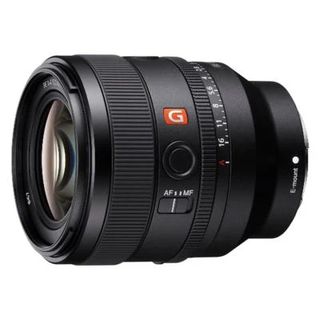
Best 50mm for almost everyone
The Sony FE 50mm f/1.4 is the lens that is most suited to most Sony shooters, impressively light and compact, but not compromising one bit on optical quality, this lens is almost perfect when it comes to sharpness in the center.
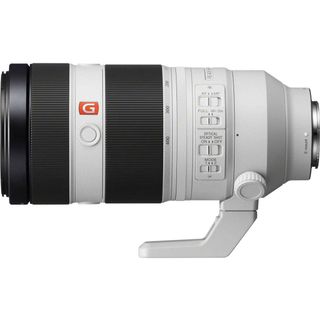
Best super-telephoto zoom
Blending superb sharpness with well-pitched handling that supports hand-held shooting, this is the ideal lens for a long day capturing sports or wildlife on an A7R-series camera.
Best lenses for the Sony A7R III and A7R IV
Why you can trust Digital Camera World
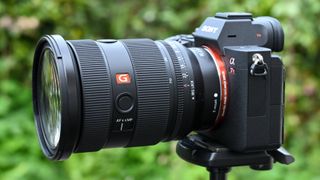
Was there anything wrong with the original Sony FE 24-70mm F2.8 GM? No. Is this updated version better in every way? Absolutely. Honoring the name of its flagship G Master series, Sony has delivered a professional-grade zoom that is pin-sharp across its entire image frame, more comprehensively weather-sealed than the previous lens, and yet, somehow, is also 20 per cent lighter and 18 per cent smaller than the previous version. Witchcraft.
Handling has been revamped and is better than ever, the optical layout is completely revamped, and the lens boasts a new floating autofocus system powered by four XD (eXtreme Dynamic) linear stepping motors. It's incredibly precise, as we extolled in our review, and the technical quality is unimpeachable. Our exacting lab tests revealed a basically faultless lens across its zoom range.
Of course, all this quality comes at a cost. While we firmly think that the Sony FE 24-70mm f/2.8 GM II is worth its price tag, if your budget doesn't stretch that far, the original Sony FE 24-70mm F2.8 GM is still a solid buy. Also worth considering is the Samyang AF 24-70mm F2.8 FE, a trinity zoom that received glowing plaudits in our review for the sheer value for money it offers.
Read our full Sony FE 24-70mm f/2.8 GM II full review for more details
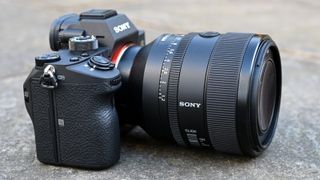
The Sony FE 50mm F1.2 G Master is a spectacular nifty-fifty, boasting impressive sharpness right the way through its aperture range – yes, even at f/1.2. Sony has built this lens from the ground up with sharpness in mind, and its optical path includes three XA (extreme aspherical) elements that have been engineered to a surface-precision tolerance of 0.01 microns.
What this means, as we found in our review, is that the lens performance is absolutely stellar – blowing away its rivals from the likes of Canon and Nikon. Our lab tests reported basically nothing in terms of imperfections, except for some pincushion distortion, and a little vignetting at f/1.2
The handling too is excellent. It's a heavy lens, as it needs to be with specs like these, but not exceptionally so in the pantheon of 50mm f/1.2 lenses. This is an all-around fantastic optic, and if its asking price isn't too dear for you, it'll deliver nothing short of spectacular performance.
Read our full Sony FE 50mm F1.2 G Master full review for more details

A 35mm f/1.4 lens is nothing new, but the Sony FE 35mm F1.4 G Master is something quite special, if only for how good its results are at that maximum aperture. After all, more than a few lens have come with this aperture rating, while delivering wide-open results so soft that you might as well not bother. Not so with this G Master prime, as we discovered when we reviewed the lens – provided you nail the focusing, the wide-open image quality is astonishingly good. It really expands the utility of the lens.
A good 35mm is ideal for street and general-purpose photography, and as such, it needs an autofocus system that can keep up. The Sony FE 35mm F1.4 G Master passes this test admirably thanks to its twin XD linear motors, which deliver friction-free autofocus with no moving parts. It is just silky smooth in every aspect of operation, including its declickable aperture ring. Every aspect of the lens feels well thought-through, and its quality makes it the ideal complement for the high-resolution sensors of Sony A7R cameras.
If this lens is too expensive, then we'd also thoroughly recommend, the Sony FE 35mm f2.8 ZA Carl Zeiss Sonnar T*, a tiny prime lens at the same focal length that's less than half the price, and received a high score in our review.
Read our full Sony FE 35mm F1.4 G Master full review for more details

The Sony FE 50mm f/1.4 is the lens that is most suited to most Sony shooters, impressively light and compact, but not compromising one bit on optical quality, this lens is almost perfect when it comes to sharpness in the center. With only a small falloff towards the edges of the frame and some vignetting wide open, this lens gets almost full marks.
The 50mm perspective offers a very versatile focal length, and it is definitely a lens that can be left on your camera for a moment's notice. If you don't need the extra aperture stop, or the added size, weight, or considerable cost of the FE 50mm f/1.2 GM, then the Sony FE 50mm f/1.4 will serve you perfectly.
Unfortunately, the downside is the lens is expensive when compared to similar rivals, with much cheaper third-party glass out there that will achieve similar visual results. However, few which share quite the same size and weight, lightning-fast autofocus, and solid moisture-resistant construction that this lens offers.
Read our full Sony FE 50mm f/1.4 GM review.
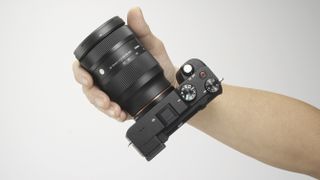
We're always on the lookout for great budget alternatives to popular lenses, and this optic from SIgma is a doozy. The Sigma 28-70mm f/2.8 DG DN | C knocks only 4mm off the wide-end of the standard workhorse 24-70mm focal length, and in doing so, delivers a lens that's light enough to take everywhere, at a seriously tempting price. The centre sharpness of the lens is excellent, as we discovered when we reviewed it, though we did note some drop-off in the corners that is worth being aware of.
Still, a constant aperture of f/2.8 on a lens this affordable is no mean feat. If you need an even cheaper option and can live with a slower, variable aperture, then try the Sony FE 28-70mm f/3.5-5.6 OSS, a neat little zoom we've reviewed that comes at a tempting price.
Read our full Sigma 28-70mm f/2.8 DG DN | C full review for more details

We were hugely excited to see the coveted G Master line-up of lenses getting a 100-400mm optic, and the Sony FE 100-400mm f/4.5-5.6 G Master OSS did not disappoint. Blending superb sharpness with well-pitched handling that supports hand-held shooting, this is an ideal lens for long day capturing sports or wildlife on an A7R camera.
Indeed, in our review we couldn't say enough good things about this lens. Its impressively complex optical path gives it excellent image quality across the board, while the handling is nothing short of impeccable. The focus operates smoothly, the three customisable buttons give you real customisability, and the ‘zoom smoothness’ ring lets you adjust the torque required to move the zoom in accordance with your preferences.
Read our full Sony FE 100-400mm f/4.5-5.6 G Master OSS full review for more details

A classic 70-200mm telephoto zoom lens makes it into almost every professional photographer’s kit bag at one time or another, and many enthusiasts’ too. It’s so versatile that it performs well at a wide variety of subjects, perfect for low light concert photography because of its wide f/2.8 aperture which is constant throughout the zoom range, and ideal for portraits due to easy subject isolation.
The G Master quality shines through in this lens in the form of an XA (extreme aspherical) element and ED (Extra-low Dispersion) elements that keep color fringing and lens distortion to a minimum.
Read our full Sony FE 70-200mm f/2.8 GM OSS full review for more details
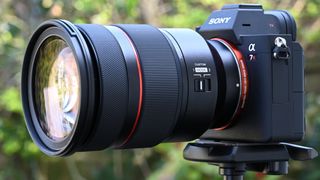
Also badged as ‘Rokinon’, the Samyang AF 24-70mm F2.8 FE is the company’s first-ever zoom lens but the manufacturer has certainly hit the ground running. Typical of a ‘trinity’ standard zoom, it combines a classic range of focal lengths with a constant aperture design. Built for Sony full-frame E-mount mirrorless cameras, it’s typically large and weighs in at just over a kilogram, making it a bit of a hefty proposition for Sony’s smaller cameras. Either way, this Samyang goes head to head with the excellent Sony FE 24-70mm f/2.8 G Master zoom (above), but costs just half the price!
Read our full Samyang AF 24-70mm F2.8 FE full review for more details

A retooling of the already excellent DSLR lens, the Sigma 150-600mm f/5-6.3 DG DN OS Sports is a great lens for bird photography, airshows and all manner of different sporting occasions.
The autofocus is excellent, though you'll need to make sure your camera is set up properly to take advantage of it. The build quality of the lens is also impressive – while no one is going to pretend this is a lightweight lens, it handles well, with tactile zoom and focus rings and a series of on-body controls for functions like AF speed, stabilization intensity, and in a new addition for the mirrorless version, Zoom Torque control to adjust the resistance of the zoom ring.
See our full Sigma 150-600mm f/5-6.3 DG DN OS Sports review
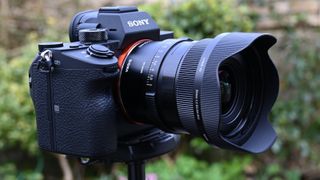
If you shoot architecture and interiors, or just prefer to take a wider perspective, the Sigma 20mm F2 DG DN | C is an ideal lens to pair with your Sony A7R camera. It's a small, metal-bodied and robust lens with loads of sublime handling features, not least of which is the aperture ring. A small point perhaps, but we always appreciate it when a lens-maker sees fit to add one.
With a high-quality optical path, the Sigma 20mm F2 DG DN | C produces images of impressive sharpness and detail – in our lab tests, we found that sharpness remained impressive even when the lens was used wide-open at f/2. There is noticeable distortion, though it's correctable via software, and colour fringing is pleasingly negligible even in the corners of the frame.
Read our full Sigma 20mm F2 DG DN | C full review for more details
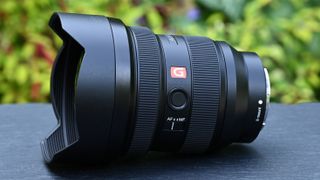
This ultra wide zoom kicks things up a notch compared with its f/4 cousin, both in terms of optical quality and price. However, for those that want uncompromising quality for their A7R III and IV this is the ultra wide to have. Capable of shooting as wide as f/2.8 makes it perfect for astrophotography and low light, and the Nano AR Coating II reduces flare and ghosting impressively.
Autofocusing is fast and accurate, capable of tracking subjects with ease because of the XD Linear Motors which operate speedily and quietly. There’s no traditional filter thread on the front element though – for that, you’ll need to attach gel filters to the rear of the lens.
Read our full Sony FE 12-24mm f/2.8 GM full review for more details

It's not every third-party manufacturer that's brave enough to go toe-to-toe with Sony's G Master lenses, but the Samyang AF 135mm F1.8 FE is one that pulls it off. This lens is half the price of Sony's version, and is absolutely excellent, earning a perfect score in our review. Its robust, weather-sealed build boasts exceptional handling, its autofocus perfectly synergises with the latest Sony cameras like the A7R IV, and its image quality is top-notch. We were seriously impressed with the results we achieved with the Samyang AF 135mm F1.8 FE in our lab testing – at f/4, the lens achieved incredibly consistent sharpness from the centre of the frame to the corners, which is not a result you see every day.
The Sony FE 135mm f1.8 GM is a near-faultless lens, also achieving the full five stars in our review. If you need the absolute best, it's probably the buy, but the Samyang is an incredible achievement for half the price.
Read our full Samyang AF 135mm F1.8 FE full review for more details

Many portrait photographers swear by the 85mm short telephoto focal length, and if you're looking to shoot compelling images of people, the Sony FE 85mm f1.4 GM lens is one of the smartest buys you can make. Something that's critical in portrait photography is being able to produce images with smooth, attractive bokeh (the defocused areas of an image), and the G Master lens delivers that in spades thanks to its 11-bladed aperture.
Sharpness and image quality are exceptional, as we discovered when we reviewed the lens, and the high-grade construction means that handling is perfectly on point. If you need a cheaper alternative though, the Sony FE 85mm f1.8 comes at about a third of the price, and still delivers a lot of the characteristics that portrait photographers are looking for.
Read our full Sony FE 85mm f1.4 GM full review for more details

Fitted with helpful distance markers, this true to life macro lens has a 1:1 reproduction ratio (1.0x magnification) which a lens has to reach before it can be considered a true macro lens. It’s great value for money and focuses to infinity so it can be used as a standard lens too. It’s ideal for portraiture due to the longer focal length and wide f/2.8 aperture.
Optical SteadyShot (OSS) stabilization keeps the frame steady when shooting, which aids enormously when photographing macro subjects. A minimum focusing distance of 28cm brings tiny details to the fore and the autofocus/manual switch can be engaged via a pull on the focus ring itself.
Read our full Sony FE 90mm f/2.8 Macro G OSS full review for more details
How we test lenses
We test lenses using both real world sample images and lab tests. Our lab tests are carried out scientifically in controlled conditions using the Imatest testing suite, which consists of custom charts and analysis software that measures resolution in line widths/picture height, a measurement widely used in lens and camera testing. We find the combination of lab and real-word testing works best, as each reveals different qualities and characteristics.
You might like to look at the best lenses for Sony A6000 cameras, or head to the best mirrorless cameras you can get if that's the type of camera that you're interested in. Wondering what the difference is between the Sony A7R IV vs A7R III vs A7R II?





